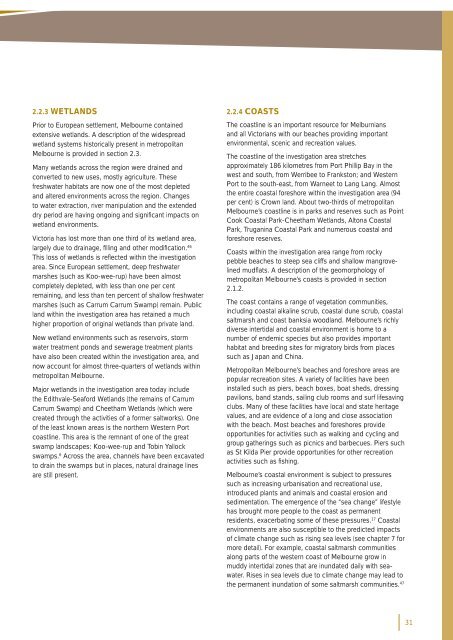Metropolitan Melbourne Investigation Discussion Paper - Victorian ...
Metropolitan Melbourne Investigation Discussion Paper - Victorian ...
Metropolitan Melbourne Investigation Discussion Paper - Victorian ...
You also want an ePaper? Increase the reach of your titles
YUMPU automatically turns print PDFs into web optimized ePapers that Google loves.
2.2.3 WETLANDS<br />
Prior to European settlement, <strong>Melbourne</strong> contained<br />
extensive wetlands. A description of the widespread<br />
wetland systems historically present in metropolitan<br />
<strong>Melbourne</strong> is provided in section 2.3.<br />
Many wetlands across the region were drained and<br />
converted to new uses, mostly agriculture. These<br />
freshwater habitats are now one of the most depleted<br />
and altered environments across the region. Changes<br />
to water extraction, river manipulation and the extended<br />
dry period are having ongoing and signifi cant impacts on<br />
wetland environments.<br />
Victoria has lost more than one third of its wetland area,<br />
largely due to drainage, fi lling and other modifi cation. 46<br />
This loss of wetlands is refl ected within the investigation<br />
area. Since European settlement, deep freshwater<br />
marshes (such as Koo-wee-rup) have been almost<br />
completely depleted, with less than one per cent<br />
remaining, and less than ten percent of shallow freshwater<br />
marshes (such as Carrum Carrum Swamp) remain. Public<br />
land within the investigation area has retained a much<br />
higher proportion of original wetlands than private land.<br />
New wetland environments such as reservoirs, storm<br />
water treatment ponds and sewerage treatment plants<br />
have also been created within the investigation area, and<br />
now account for almost three-quarters of wetlands within<br />
metropolitan <strong>Melbourne</strong>.<br />
Major wetlands in the investigation area today include<br />
the Edithvale-Seaford Wetlands (the remains of Carrum<br />
Carrum Swamp) and Cheetham Wetlands (which were<br />
created through the activities of a former saltworks). One<br />
of the least known areas is the northern Western Port<br />
coastline. This area is the remnant of one of the great<br />
swamp landscapes: Koo-wee-rup and Tobin Yallock<br />
swamps. 6 Across the area, channels have been excavated<br />
to drain the swamps but in places, natural drainage lines<br />
are still present.<br />
2.2.4 COASTS<br />
The coastline is an important resource for Melburnians<br />
and all <strong>Victorian</strong>s with our beaches providing important<br />
environmental, scenic and recreation values.<br />
The coastline of the investigation area stretches<br />
approximately 186 kilometres from Port Phillip Bay in the<br />
west and south, from Werribee to Frankston; and Western<br />
Port to the south-east, from Warneet to Lang Lang. Almost<br />
the entire coastal foreshore within the investigation area (94<br />
per cent) is Crown land. About two-thirds of metropolitan<br />
<strong>Melbourne</strong>’s coastline is in parks and reserves such as Point<br />
Cook Coastal Park-Cheetham Wetlands, Altona Coastal<br />
Park, Truganina Coastal Park and numerous coastal and<br />
foreshore reserves.<br />
Coasts within the investigation area range from rocky<br />
pebble beaches to steep sea cliffs and shallow mangrovelined<br />
mudfl ats. A description of the geomorphology of<br />
metropolitan <strong>Melbourne</strong>’s coasts is provided in section<br />
2.1.2.<br />
The coast contains a range of vegetation communities,<br />
including coastal alkaline scrub, coastal dune scrub, coastal<br />
saltmarsh and coast banksia woodland. <strong>Melbourne</strong>’s richly<br />
diverse intertidal and coastal environment is home to a<br />
number of endemic species but also provides important<br />
habitat and breeding sites for migratory birds from places<br />
such as Japan and China.<br />
<strong>Metropolitan</strong> <strong>Melbourne</strong>’s beaches and foreshore areas are<br />
popular recreation sites. A variety of facilities have been<br />
installed such as piers, beach boxes, boat sheds, dressing<br />
pavilions, band stands, sailing club rooms and surf lifesaving<br />
clubs. Many of these facilities have local and state heritage<br />
values, and are evidence of a long and close association<br />
with the beach. Most beaches and foreshores provide<br />
opportunities for activities such as walking and cycling and<br />
group gatherings such as picnics and barbecues. Piers such<br />
as St Kilda Pier provide opportunities for other recreation<br />
activities such as fi shing.<br />
<strong>Melbourne</strong>’s coastal environment is subject to pressures<br />
such as increasing urbanisation and recreational use,<br />
introduced plants and animals and coastal erosion and<br />
sedimentation. The emergence of the “sea change” lifestyle<br />
has brought more people to the coast as permanent<br />
residents, exacerbating some of these pressures. 17 Coastal<br />
environments are also susceptible to the predicted impacts<br />
of climate change such as rising sea levels (see chapter 7 for<br />
more detail). For example, coastal saltmarsh communities<br />
along parts of the western coast of <strong>Melbourne</strong> grow in<br />
muddy intertidal zones that are inundated daily with seawater.<br />
Rises in sea levels due to climate change may lead to<br />
the permanent inundation of some saltmarsh communities. 47<br />
31
















